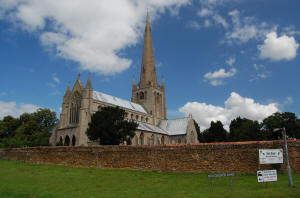Snettisham
Snettisham (pronounced Snettshum) lies in the north-west corner of Norfolk
between Heacham and Ingoldisthorpe. For many centuries
the 175ft spire of St. Mary's Church has been used as
a 'sea mark' for shipping in The Wash. The steeple was
erected by John of Gaunt, Duke of Lancaster the son of
Edward III. The village is also characterised by the use
of carr-stone as a building material. With the exception
of flint, carr-stone is Norfolk's only other workable stone.

St. Mary's Church
In The Shrimp and the Anemone L.P. Hartley
fictionalised Snettisham as Frontisham. In the novel
Eustace undergoes a religious experience in the church:
|
| 'Meanwhile the
interstices, the spaces where he was not, began to fill
with stained glass. Pictures of saints and angels, red,
blue and yellow, pressed against and into him, bruising
him, cutting him, spilling their colours over him. The
pain was exquisite, but there was rapture in it too.
Another twitch, a final wriggle and Eustace felt no
more; he was immobilised, turned to stone. High and
lifted up, he looked down from the church wall, perfect,
pre-eminent, beyond criticism....to be admired and
worshipped by hundreds of visitors.....Eustace of
Frontisham, Saint Eustace.' |
In 1962 the poet laureate John Betjeman travelled
by train from King's Lynn to
Hunstanton and made a stop
at Snettisham station. He dismounted here and waited for
the next train to arrive - while musing about the
differences between Wolferton and Snettisham. The entire
line was scrapped by Dr Beeching soon after.
Snettisham is also famous for its RSPB reserve - where
thousands of waders, duck and geese feed on the mudflats
of The Wash. The Wash provides the backdrop for a very
moving poem by the Manx poet David Callin.
|
|
Snettisham This is the Wash
it seems -
a last exhalation
of the dying land, or something
the sea's been working on
for ages: sketching it in,
rubbing it out,
redoing and redoing it,
never satisfied.
Look at you, all wrapped up,
hat and scarf and
gloves, and those wild eyes
made weak by medication
and hopes confounded so
so many times.
Never this thin before.
Going slowly, in this
flattest part of England,
going slowly downhill.
The birds rise
like a handful of rain
thrown upward,
and the Great Twitcher
in the sky misses
nothing. His fondness
for sparrows is well known. |
In 1991 a treasure trove of gold and silver ornaments
dating from the 1st century BC was discovered in a
farmer's field in Snettisham. Amongst the find was an
exquisite collection of gold torcs - manufactured by the
Iceni people who once occupied much of East Anglia. The queen of the Iceni,
Boudicca, was celebrated in verse by the poet William Cowper
in his poem entitled
Boadicea, An Ode. |
Links:
St Mary's Church
More photographs of Snettisham |
|

